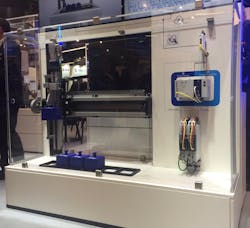Sensors are well recognized as key components of any industrial digital strategy. In fact, for years now, the deployment of more and more sensors to capture increasingly large amounts of data for analysis has been a principal recommendation for manufacturers across all industry verticals.
This has been especially true for asset condition monitoring (CM) and predictive maintenance (PM) applications. As a result, many mid-sized manufacturers are not very far along their digital transformation journey because they often cannot afford to install increasingly larger amounts of costly industrial sensors.
To get around the sensor cost issue, Lenze has been focusing on teaching customers how to get this added data for CM and PM applications from devices they already have installed.
At the SPS (Smart Production Solutions) 2019 event in Nuremberg, Germany, Prof-Dr. Holger Borcherding, head of innovation at Lenze, noted that the company is helping OEMs and other end users “extract the added information value from existing data sources through the use of pre-tested algorithms from Lenze that help mechanical engineers turn their process expertise and knowledge of machines into a condition monitoring model that will improve efficiency.”
Using an example of a 2-axis robot in the Lenze booth, Lenze showed both a model-based and data-based approach to condition monitoring using data from the robot’s drive.
In the model-based example, actual values from the robot’s controller are measured are compared with those from Lenze’s mathematical description of the robot. If certain tolerances are exceeded, this is interpreted as a fault. In the data-based approach, a Lenze-developed algorithm learns the robot’s behavior based on the influences of parameters, such as velocity, acceleration, torque, position, and current consumption. The real values are then compared with the description to define deviations.
Borcherding explained that the model-based evaluation usually takes place on the control system, because it does not require any significant computing power. However, the use of Lenze’s machine learning and artificial intelligence technologies in the data-based analyses typically require its calculations to be conducted in Lenze’s x4 cloud application with data sent via Lenze’s x500 gateway. Borcherding did note that data-based evaluations can also be performed locally using Lenze’s c750 cabinet controller.
Underscoring his point that efficient condition monitoring is possible based on the interpretation of existing data, Borcherding stressed that “no additional sensor technology is needed. Instead, the machine’s drives can work as sensors. With our automation portfolio of hardware, software, networks, cloud applications, and consulting expertise, Lenze can help manufacturers become data scientists for their machines."


